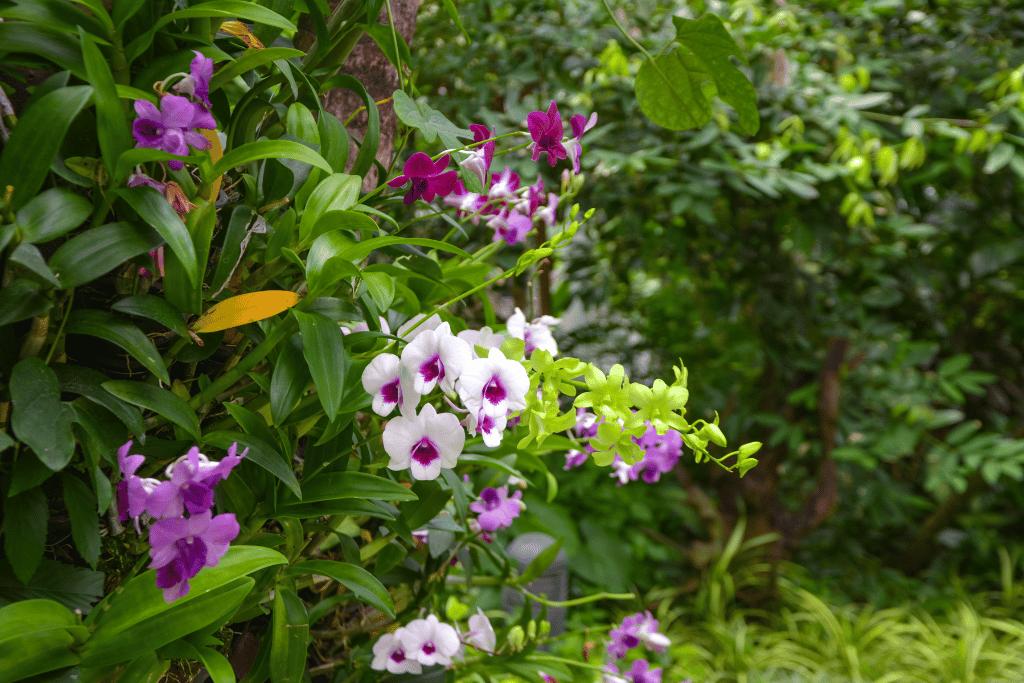I absolutely love gardening, and flowers have a special place in my heart. I’m really curious about all kinds of flowers and their unique traits. In fact, for a long time, I’ve wanted to make a list of flowers and gather interesting information about them. That’s why I’m writing this article.
Today, I’ll be taking you on a fun journey into the fascinating world of flowers, specifically flowers that start with the letter “A.” To me, each flower has its own charm and story to tell.
So, let’s explore together and learn about these amazing blooms! Shall we?
1. Amaryllis – Graceful Trumpets of Radiance
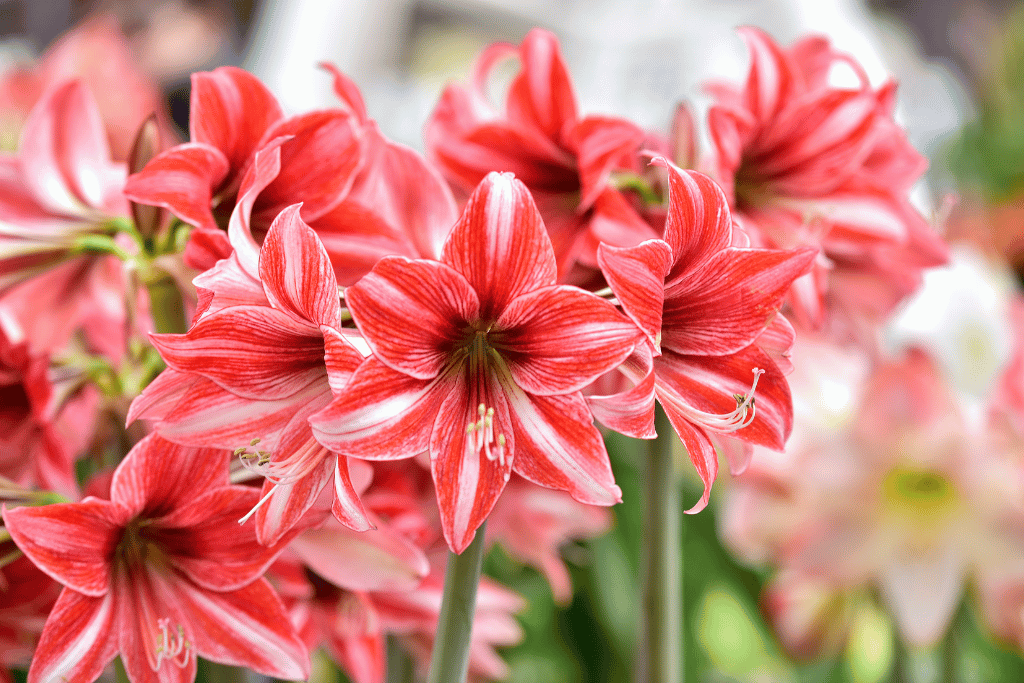
Amaryllis, with its botanical name Hippeastrum, is renowned for its stately and striking appearance. This bulbous perennial plant produces large, trumpet-shaped flowers atop tall, leafless stems.
This stunning beauty is available in various colors, such as red, white, pink, and orange; Amaryllis adds a touch of elegance to homes and gardens, particularly during the festive season.
These majestic blooms exude an air of grandeur, symbolizing pride, determination, and radiant beauty. The Amaryllis is a popular choice for floral arrangements and as a gift for loved ones. It requires well-draining soil and bright, indirect light to thrive. When properly cared for, Amaryllis bulbs can bloom year after year, gracing indoor and outdoor spaces with their regal splendor.
2. Azalea – A Springtime Symphony in Colors

As a symbol of femininity and love, Azaleas are often associated with grace and elegance. These charming plants showcase a profusion of colorful, tubular flowers that bloom in various shades of pink, red, purple, white, and even bi-colored varieties. Azaleas, belonging to the Rhododendron family, are iconic flowering shrubs cherished for their spectacular spring blooms.
Native to Asia and parts of North America, Azaleas prefer acidic, well-draining soil and partial shade, making them ideal choices for woodland gardens and shaded landscapes. Their captivating beauty attracts pollinators like bees and butterflies, contributing to the biodiversity of the ecosystem.
Azaleas have long been beloved by gardeners and enthusiasts, captivating hearts with their springtime symphony of colors.
3. Aster – Nature’s Dazzling Starlets

Asters, with their daisy-like appearance, are true dazzlers in the late summer and fall garden. Their petite blooms form clusters atop sturdy stems, creating a radiant spectacle that attracts bees, butterflies, and other pollinators. These star-shaped flowers belong to the Asteraceae family, and they come in a wide range of colors, including various shades of purple, blue, pink, and white.
The Aster’s botanical name is derived from the Greek word “aster,” meaning star, which perfectly captures their celestial charm. Beyond their visual appeal, Asters hold significant symbolism, representing patience, elegance, and love. They are popular choices for cut flowers, adding a touch of natural beauty to floral arrangements and bouquets. Gardeners cherish Asters for their ability to extend the flowering season, bringing a burst of color to the garden when other blooms begin to fade.
4. Anemone – Windswept Beauty in Ethereal Grace
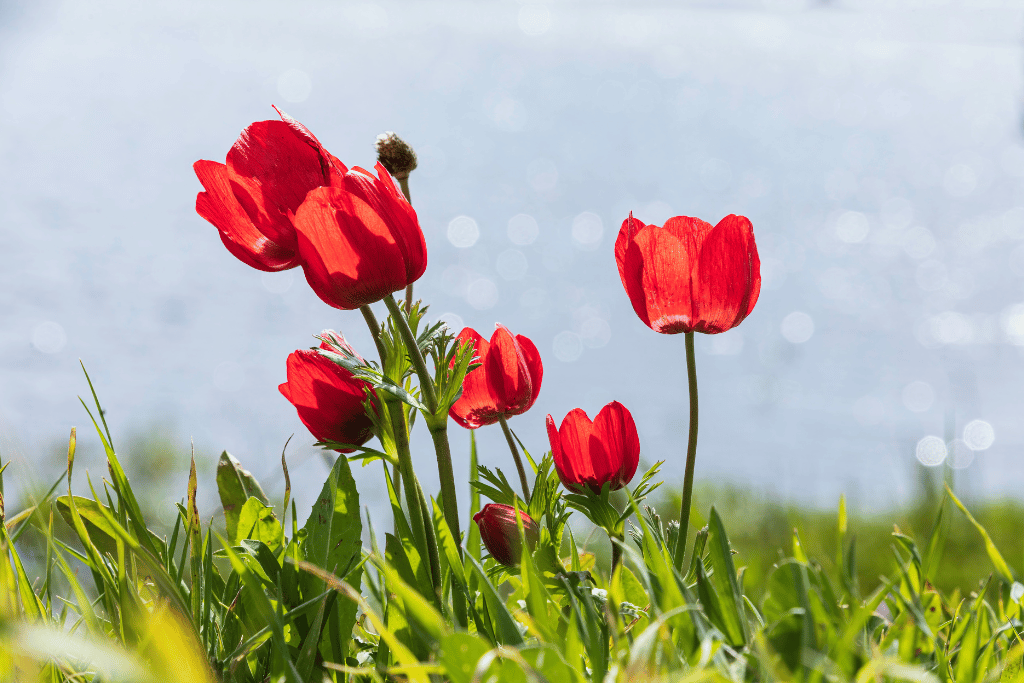
Anemones are available in various colors, including pure white, soft pink, rich purple, and vibrant red. They, known as Windflowers, are enchanting perennial plants celebrated for their delicate, windswept appearance. These ethereal blooms come in Each flower boasts a cluster of petal-like sepals surrounding a sunny center of golden stamens.
In Greek mythology, Anemones are associated with the tale of the love between Adonis and Aphrodite, adding a layer of romantic symbolism to these blossoms.
Anemones symbolize anticipation, fragility, and protection against evil. Often found in woodland settings and rock garden, these graceful flowers sway gently in the breeze, captivating the senses with their poetic beauty.
5. Alstroemeria – Peruvian Lily’s Timeless Grace
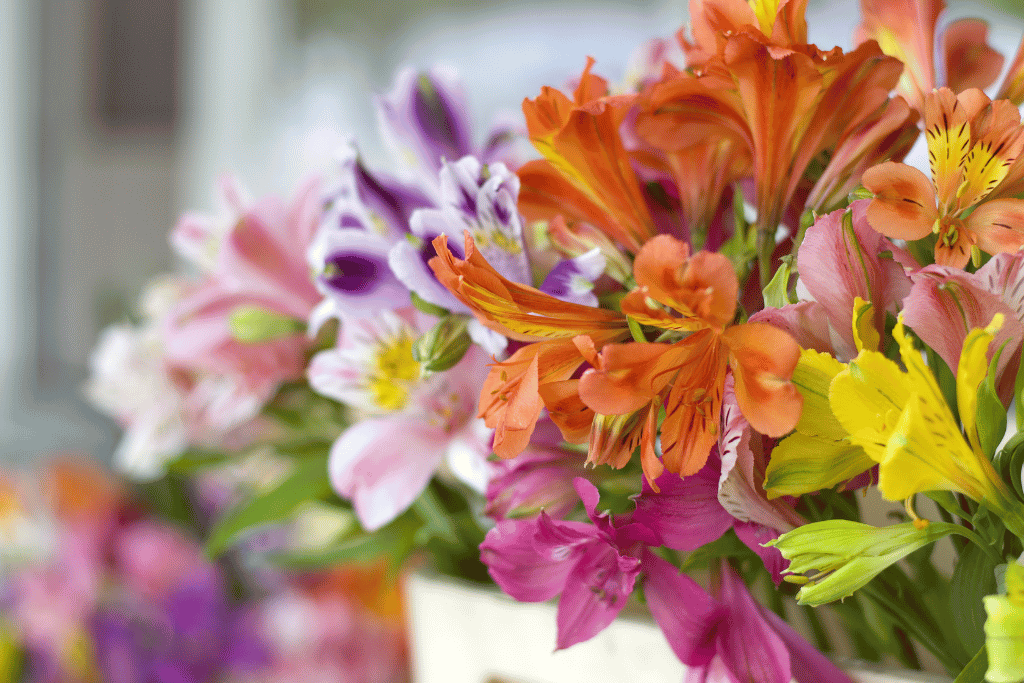
The beauty queen, Alstroemerias are low-maintenance and relatively easy to grow, making them beloved by gardeners and flower enthusiasts alike. They are native to South America, particularly Peru, Alstroemeria blooms come in an array of colors, ranging from soft pastels to bold and vibrant hues. Their unique markings, resembling speckles or freckles, add to their allure.
Alstroemeria, commonly known as the Peruvian Lily or Lily of the Incas, is a delightful flowering plant cherished for its timeless grace and versatility. Symbolizing friendship, devotion, and prosperity, Alstroemerias are popular choices for floral arrangements, bouquets, and gift-giving on various occasions. They hold up well as cut flowers, often lasting for weeks in a vase.
6. Allium – Architectural Wonders of Nature

Alliums are herbaceous perennials showcase large, spherical flower heads composed of numerous tiny star-shaped blooms. They commonly known as Ornamental Onions, are architectural wonders in the garden. Alliums come in a range of sizes and colors, from delicate purples and blues to bold pinks, whites, and yellows.
These unique blooms attract pollinators, adding both beauty and biodiversity to the landscape. Alliums thrive in well-draining soil and full sun, gracing gardens with their structural elegance and whimsical appeal.
With their intricate flower heads and long-lasting blooms, Alliums create a captivating spectacle that often becomes a focal point in garden design.
7. Agapanthus – Lily of Infinite Affection
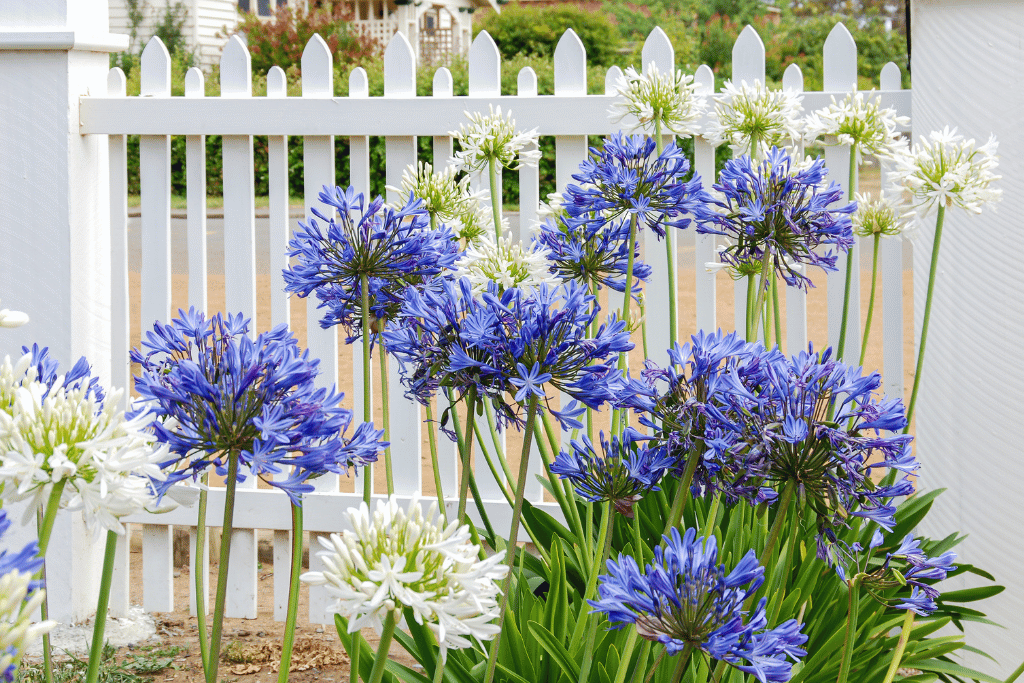
Agapanthus are hardy perennials that prefer well-draining soil and thrive in full sun to partial shade. Agapanthus’s striking appearance and easy-care nature have made it a beloved choice for adding a touch of sophistication to outdoor spaces.
Agapanthus, commonly known as the Lily of the Nile or African Lily, is a stunning flowering plant originating from Southern Africa. Characterized by its long, slender stems and clusters of trumpet-shaped blooms, Agapanthus stands tall in gardens and landscapes.
The flowers range in color from rich blues and purples to bright whites, exuding an air of elegance and refinement. Symbolizing love, affection, and beauty, Agapanthus is a popular choice for both formal and informal gardens.
8. Aconitum – Bewitching Beauty with a Dark Secret
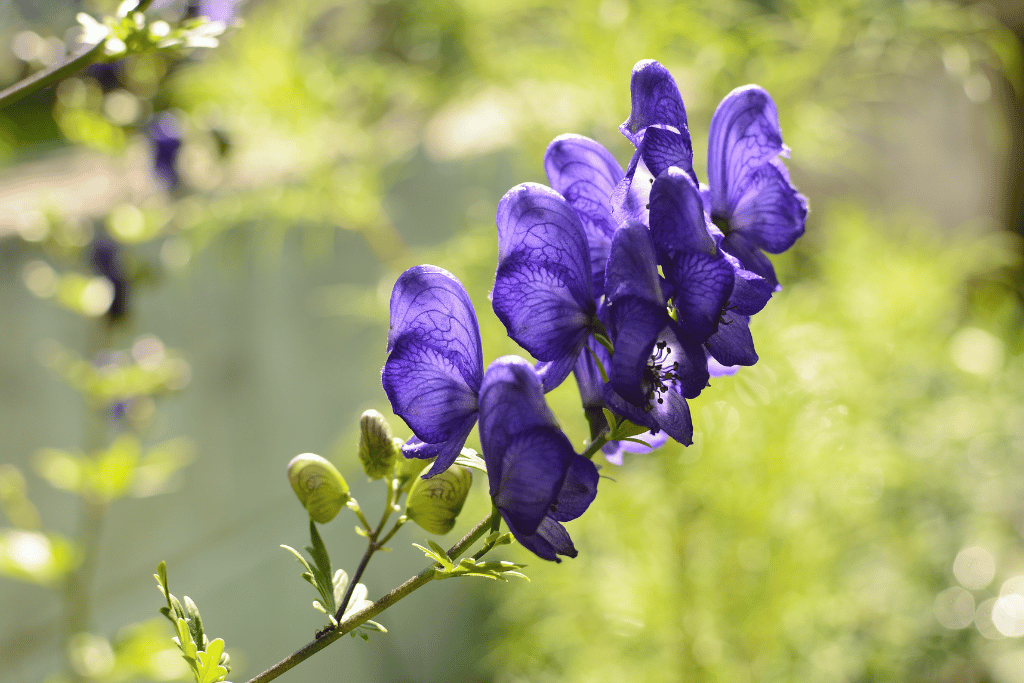
Despite its captivating beauty, Aconitum is one of the most poisonous plants in the world, containing potent toxins. Revered for its mythical and medicinal significance, Aconitum has been associated with magical properties and used in traditional herbal medicine. It is essential to handle Aconitum with care, but its enigmatic allure continues to intrigue and inspire fascination.
Aconitum, commonly known as Monkshood or Wolfsbane, is a bewitching flower shrouded in mystery and myth. This herbaceous perennial boasts tall, spike-like racemes adorned with hood-like flowers. Aconitum’s striking colors range from deep purples and blues to rich violets and whites.
9. Armeria – Coastal Beauty in Full Bloom
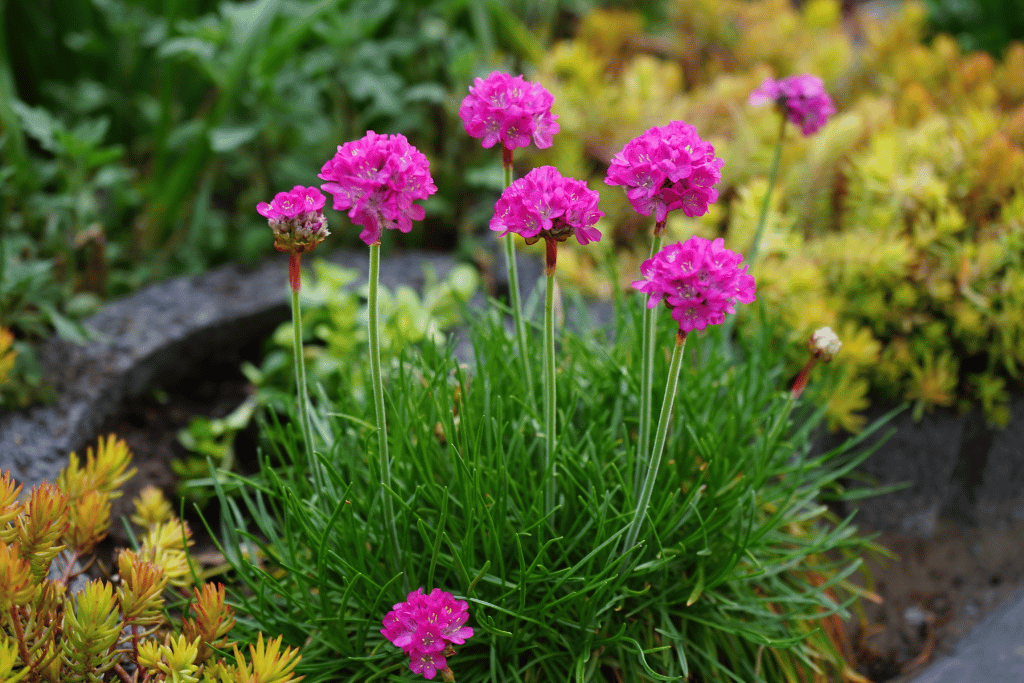
Armeria, commonly known as Sea Thrift or Thrift, is a charming flowering plant that flourishes in coastal environments. Its compact, grass-like foliage gives rise to globe-shaped clusters of pink or white flowers, creating a delightful display that resembles a cotton candy-like tuft.
As a symbol of endurance and the beauty found in challenging landscapes, Armeria thrives in sandy and rocky soils, making it ideal for coastal and seaside gardens.
It attracts pollinators like butterflies and bees, adding to the ecological value of the ecosystem. Armeria’s gentle allure and resilience make it a favorite among coastal gardeners and landscape enthusiasts.
10. Adonis – A Golden Tapestry of Renewal
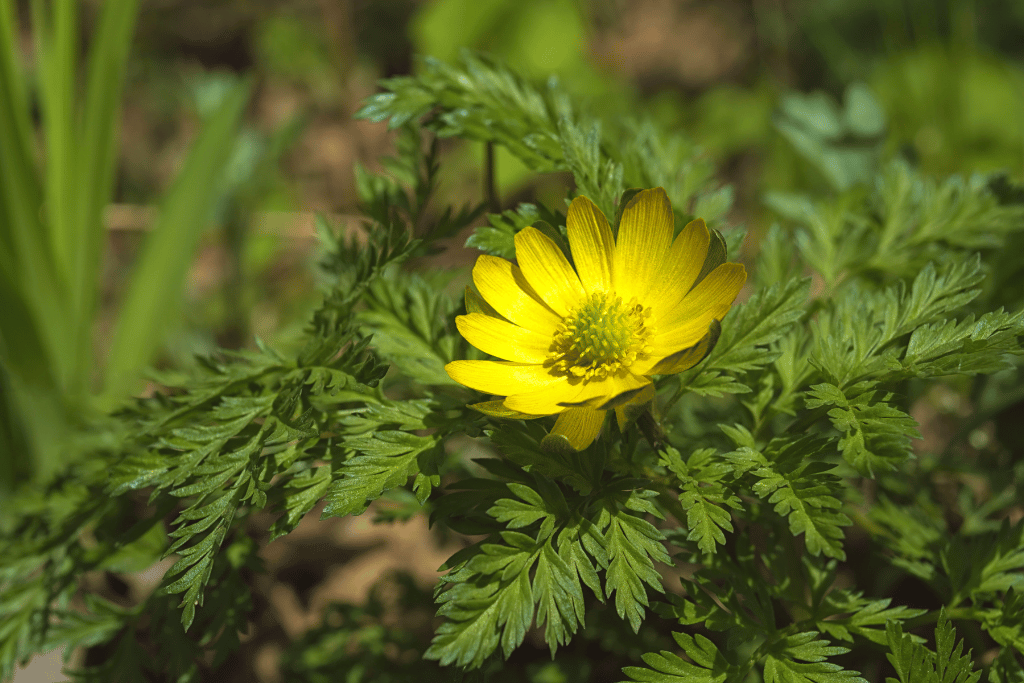
Adonis, with its botanical name Adonis amurensis, is a striking perennial plant that ushers in the early spring with a golden tapestry of blooms. This herbaceous plant features bright yellow, buttercup-like flowers that emerge as winter fades, symbolizing renewal and rejuvenation.
Adonis’s golden blooms stand out against the awakening landscape, inviting bees and other pollinators to partake in the nectar feast. As a symbol of hope and optimism, Adonis reminds us of the cyclical nature of life and the promise of new beginnings. Whether in woodland settings or garden borders, Adonis adds a touch of sunshine and charm to the early days of spring.
11. Asphodelus – Mythical Charms of Immortality
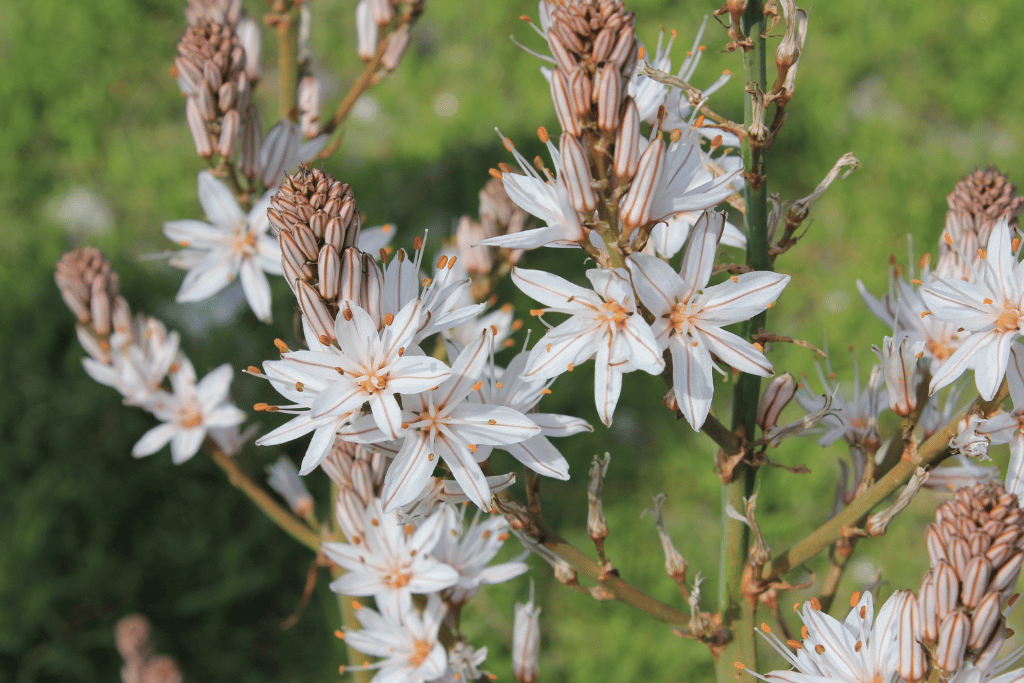
Asphodel’s simple beauty and graceful appearance make it a charming addition to cottage gardens and wildflower meadows. It thrives in well-draining soil and full sun, gracing landscapes with a touch of enchantment. While once associated with the realm of the deceased, Asphodel now captivates us with its mythical charms and historical significance.
Asphodelus, commonly known as Asphodel, is a mythical flower steeped in history and symbolism. In Greek mythology, it was associated with the afterlife and considered the food of the dead, representing immortality and eternity. This perennial plant produces tall spikes adorned with clusters of delicate, star-shaped flowers in shades of white and pale pink.
12. Achimenes – Effervescent Beauties in Pots

Native to tropical regions, Achimenes boasts velvety, trumpet-shaped flowers in an array of colors, including shades of red, pink, purple, and white. Achimenes, also known as the Hot Water Plant, is a delightful flowering plant cherished for its vibrant and effervescent blooms.
These tuberous perennials are well-suited for container gardening and indoor cultivation, where their striking flowers can be showcased up close. Achimenes’ blooming period extends throughout the warm months, providing a continuous display of beauty. Their charming appearance and easy cultivation make them a favorite among flower enthusiasts and collectors.
13. Anthurium – Flamingo Flower’s Heart-Shaped Brilliance

Anthuriums are renowned for their heart-shaped, glossy bracts, which can be red, pink, orange, or white, surrounding a prominent spadix. Anthurium, commonly known as the Flamingo Flower or Heart Flower, is an exotic and captivating plant native to tropical regions of South America.
These striking flowers symbolize hospitality and abundance, making them popular choices for floral arrangements and interior decor. Anthuriums thrive in warm, humid environments with bright, indirect light, making them ideal houseplants in temperate climates.
Their unique appearance and long-lasting blooms have earned them a place as one of the most sought-after tropical plants.
14. Alocasia – Elephant Ear’s Dramatic Foliage

Alocasias thrive in warm, humid conditions with bright, indirect light, making them ideal statement plants in both indoor and outdoor settings. They are known as Elephant Ear, a dramatic and bold plant celebrated for its impressive foliage. This tropical beauty boasts large, heart-shaped leaves with prominent veins, resembling the ears of an elephant, hence its name.
With a diverse range of species and cultivars, Alocasia offers an assortment of leaf colors and patterns, from deep greens to striking variegations. While not primarily grown for its flowers, when they do appear, they are often hidden among the foliage and inconspicuous.
15. Anethum – Herbal Delight of Dill
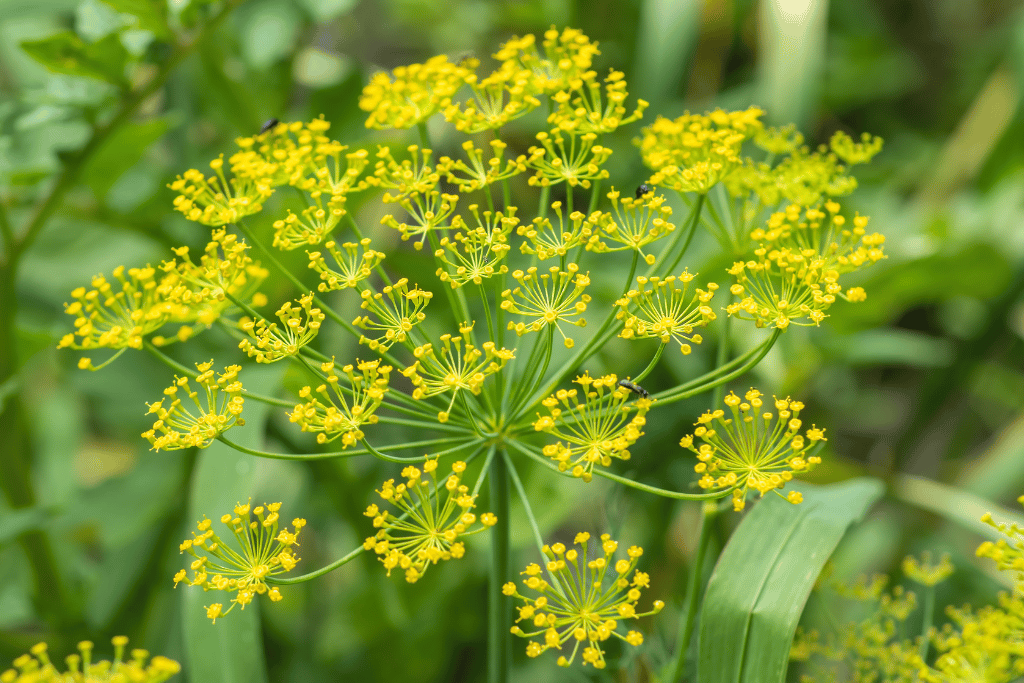
Anethum, commonly known as Dill, is a versatile and flavorful herb used both in culinary and medicinal applications. This annual herb showcases feathery, aromatic foliage and produces umbrella-like flower heads composed of small, yellow flowers.
Dill is cherished for its unique taste, often used in pickling, salads, and various dishes, adding a delightful herbal note to the culinary world. Beyond its culinary uses, Dill has been valued for its medicinal properties, including aiding digestion and soothing upset stomachs. In addition to its practical applications, Dill’s delicate appearance and pleasing aroma make it an appealing addition to herb gardens and ornamental beds alike.
16. Abutilon – Flowering Maple’s Vibrant Display
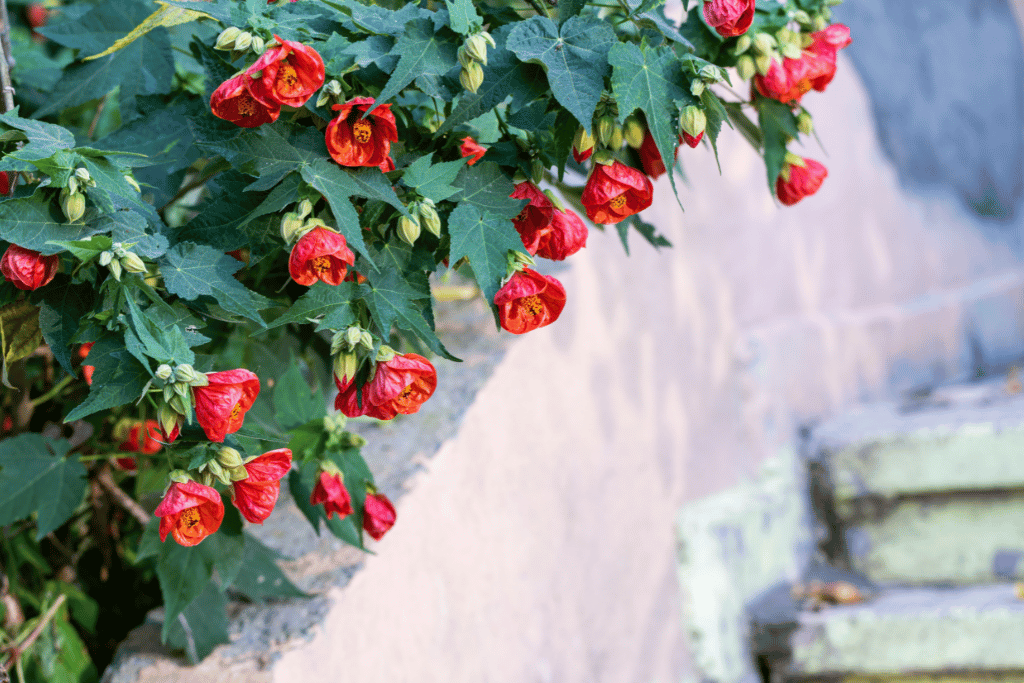
Abutilon, native to tropical and subtropical regions, Boasts bell-shaped flowers in a wide array of shades, including red, orange, yellow, pink, and white. Abutilon, commonly known as Flowering Maple, is a delightful and colorful flowering shrub belonging to the Malvaceae family.
Resembling small, intricate hibiscus blooms, Abutilons add a touch of vibrancy to gardens and landscapes. These versatile plants can be grown as shrubs, container specimens, or trained as climbers. With their nectar-rich flowers, Abutilons attract hummingbirds and other pollinators, contributing to the ecological balance of the environment.
17. Amaranthus – Cascading Tassels of Beauty

Symbolizing immortality and longevity, Amaranthus has historical significance in various cultures and remains a beloved choice for adding flair to any landscape. It is often used in dried flower arrangements and adds an exotic touch to cut flower displays. With its unique and flamboyant appearance, Amaranthus adds drama and texture to gardens and floral arrangements.
Amaranthus, commonly known as Amaranth, is an eye-catching annual plant celebrated for its cascading tassels of brilliant colors. These long, rope-like flower heads come in various shades, such as deep reds, rich burgundy, bright greens, and vivid yellows.
18. Aquilegia – Columbine’s Graceful Elegance

These charming flowers boast delicate, spurred blooms in an array of colors, including shades of blue, purple, pink, yellow, and white. Aquilegia, commonly known as Columbine, is a graceful and enchanting perennial plant that belongs to the Ranunculaceae family.
Columbines’ unique flower shape, with petals resembling bonnets or spurs, adds to their allure. They are a favorite among pollinators, attracting hummingbirds and butterflies to their nectar-rich flowers. Columbines thrive in well-draining soil and partial shade, making them ideal for woodland gardens and shaded areas. Their elegance and fairy-like appearance have made them a symbol of femininity and a cherished addition to cottage-style gardens.
19. Ageratina – White Snakeroot’s Graceful Blooms

Ageratina is commonly known as White Snakeroot, a graceful and native flowering perennial found in woodlands and natural landscapes. Its delicate white blooms form flat-topped clusters, creating a soft and airy appearance.
Apart from its ornamental value, White Snakeroot holds historical significance due to its toxic properties, which were responsible for causing milk sickness in the past. The plant contains a poisonous substance, tremetol, which could be transmitted through cow’s milk if the cows grazed on the plant. Despite this, Ageratina remains a charming wildflower that adds elegance and tranquility to native plant gardens and woodland settings.
20. Ajuga – Bugleweed’s Colorful Groundcover

The perennial plant boasts dense, mat-like foliage in shades of green, burgundy, bronze, or variegated combinations. In spring, Ajuga produces spikes of small, tubular flowers in colors like blue, purple, pink, or white, adding a delightful pop of color to the landscape. Ajuga, commonly known as Bugleweed, is a versatile and low-growing groundcover that excels in both beauty and functionality.
As a groundcover, Ajuga helps suppress weeds and erosion, making it a valuable addition to garden beds and landscape borders. Its adaptability and resilience have made Ajuga a popular choice for both novice and experienced gardeners.
21. Alcea – Majestic Towers of Hollyhocks
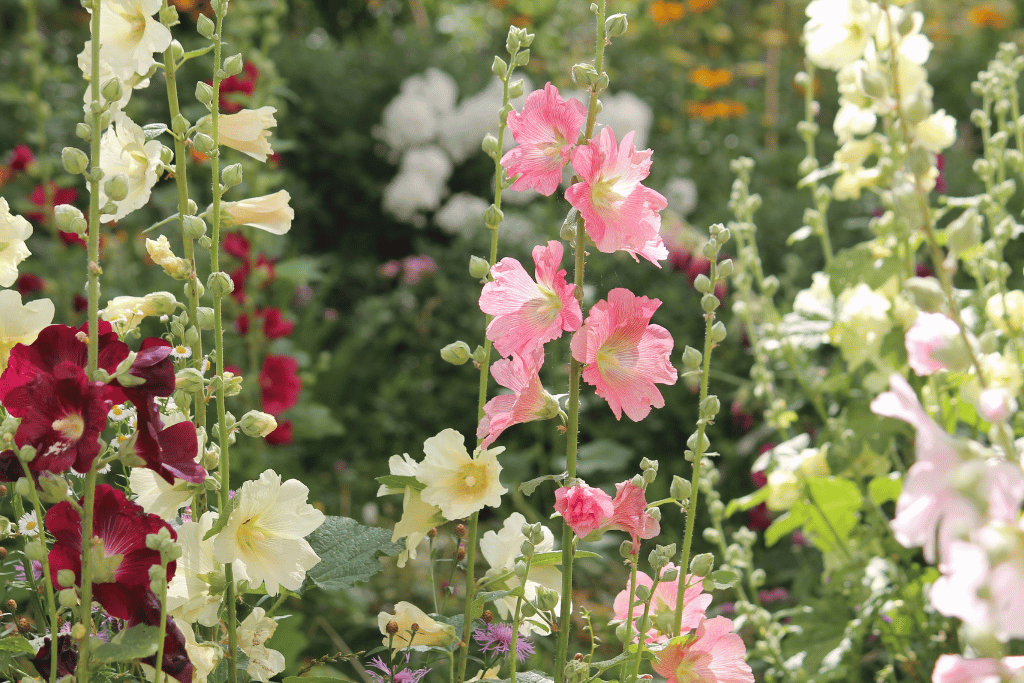
Alcea, commonly known as Hollyhocks, are majestic biennial or perennial plants cherished for their tall and stately presence. These towering beauties showcase single or double flowers in a wide range of colors, including pink, red, yellow, white, and purple.
Hollyhocks are a symbol of old-fashioned charm, often found in traditional cottage gardens and historical landscapes. Their towering spikes of blossoms attract bees and butterflies, contributing to the overall biodiversity of the garden. Hollyhocks prefer full sun and well-draining soil, gracing the landscape with their timeless grace and nostalgic allure.
22. Agathaea – Cosmos’ Delightful Cousins

Cosmos are often associated with harmony and tranquility, making them a popular choice for creating a peaceful garden sanctuary. Cosmos are known for their ease of cultivation and their ability to attract pollinators such as butterflies and bees. Their delicate appearance and airy foliage add a touch of charm to gardens, wildflower meadows, and floral arrangements.
Originating from Mexico, Cosmos come in various species, each with its unique charm and appeal. They showcase daisy-like flowers in shades of pink, white, orange, and yellow. Agathaea, commonly known as Cosmos, are delightful flowering plants that belong to the Asteraceae family.
23. Alpinia – Shell Ginger’s Tropical Beauty
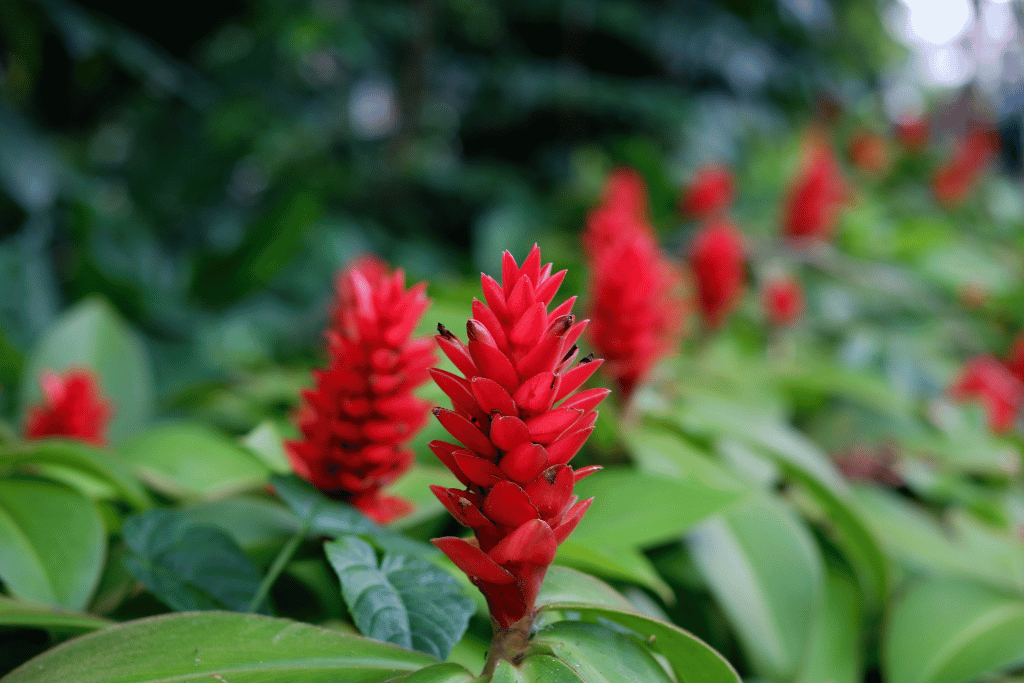
As a symbol of prosperity and beauty, Shell Ginger continues to captivate gardeners and enthusiasts in tropical and subtropical regions. This evergreen perennial boasts large, glossy leaves and show-stopping inflorescences with shell-shaped bracts that encase the true flowers. Alpinia, commonly known as Shell Ginger, is a stunning tropical plant native to Southeast Asia.
The shell-like bracts come in various colors, such as pink, red, and white, and add a touch of exotic beauty to gardens and landscapes. Apart from its ornamental value, Alpinia is valued for its medicinal and culinary uses in traditional Asian cultures.
24. Anthyllis – Kidney Vetch’s Hardy Charmer
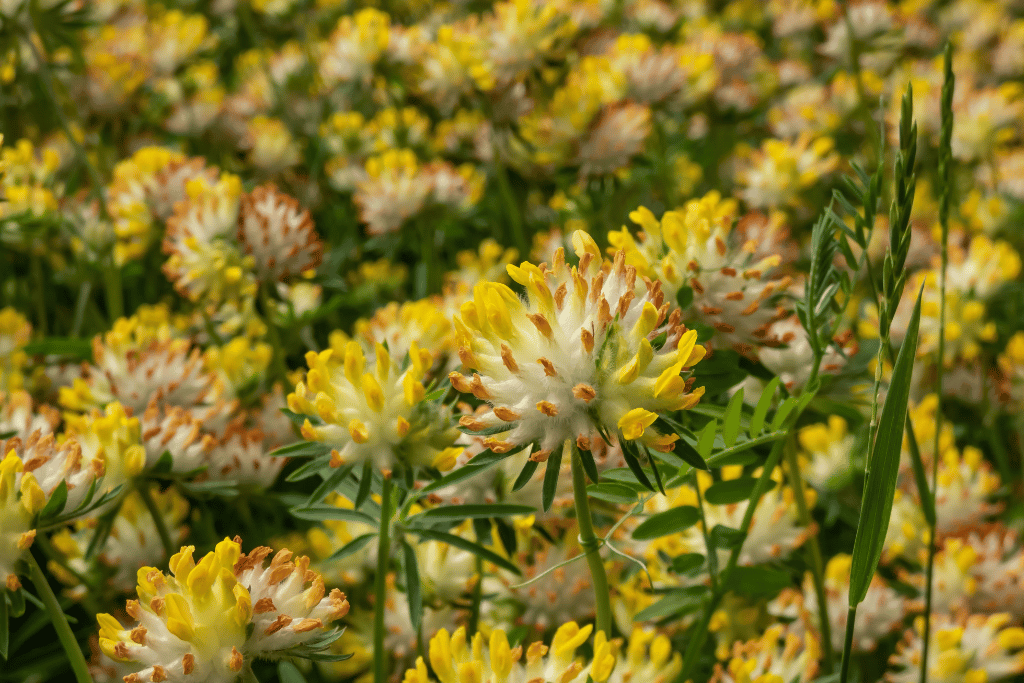
Anthyllis is known for its ability to fix nitrogen in the soil, making it valuable for enhancing soil fertility in challenging environments. The flowers attract a wide range of pollinators, including bees and butterflies, contributing to the ecosystem’s vitality. As a symbol of resilience and adaptation, Anthyllis stands as a testament to the strength and beauty of nature.
They has compact, cushion-like growth habits and small, clustered flowers make it a unique addition to rock gardens and alpine landscapes. They are commonly known as Kidney Vetch, a hardy and charming perennial plant found in various habitats, from rocky slopes to coastal cliffs.
25. Ammi – Queen Anne’s Lace’s Delicate Lacework
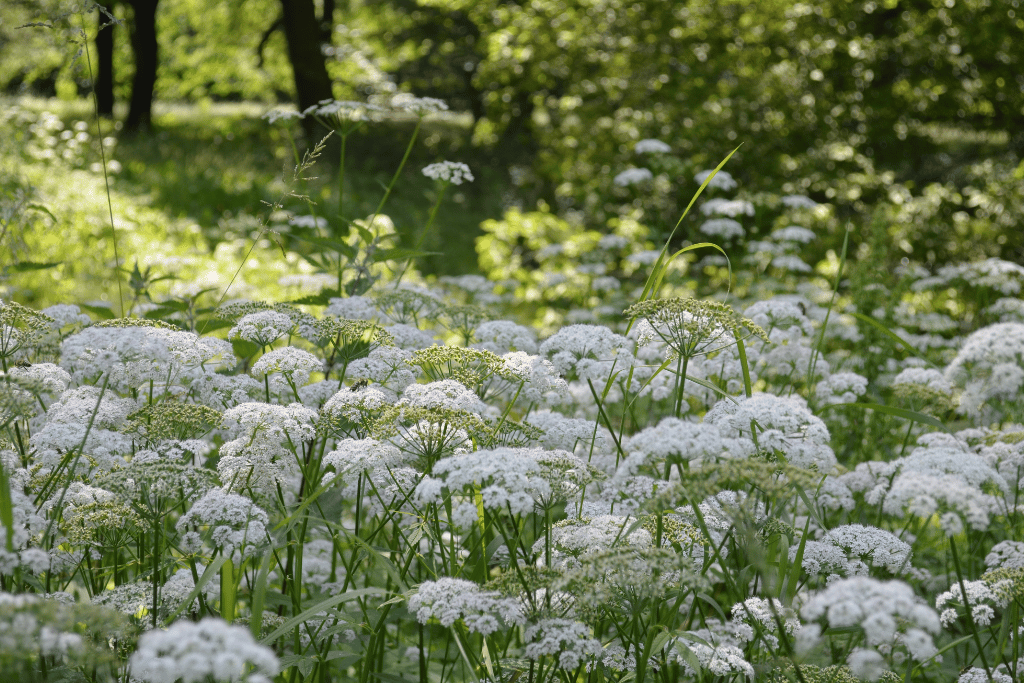
Ammi, commonly known as Queen Anne’s Lace or False Queen Anne’s Lace, is an enchanting flowering plant in the Apiaceae family. Resembling delicate lace, Ammi produces clusters of small, white flowers with a prominent central floret, creating an intricate and airy appearance.
Native to Europe and Asia, Queen Anne’s Lace has become naturalized in many regions worldwide. While it boasts a graceful beauty, it is essential to differentiate it from the poisonous Hemlock plants. Queen Anne’s Lace attracts butterflies and other pollinators, making it a valuable addition to pollinator-friendly gardens and wildflower meadows. Its delicate charm and versatility have made Ammi a beloved choice for both gardeners and floral designers.
26. Anigozanthos – Kangaroo Paw’s Unique Splendor
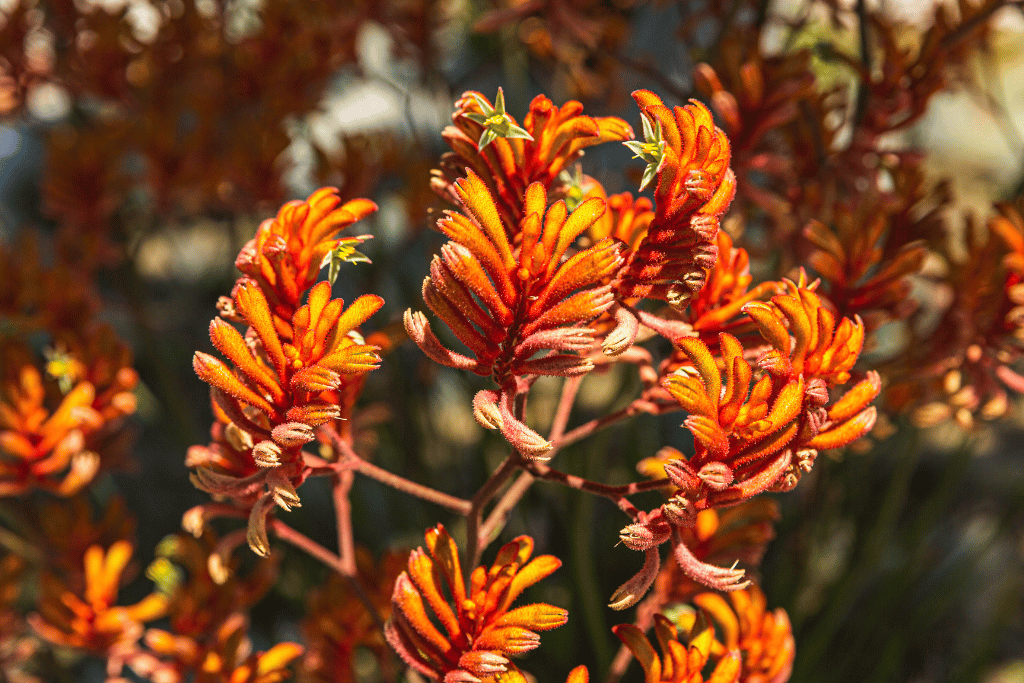
Anigozanthos blooms come in a wide array of colors, including shades of red, yellow, orange, and green, adding a splash of vibrancy to gardens and landscapes. Anigozanthos, commonly known as Kangaroo Paw, is a fascinating and distinctive plant native to Australia. Its name is derived from its unique, paw-like flowers with velvety tubular structures and claw-like tips, resembling a kangaroo’s paw.
Apart from their ornamental value, Kangaroo Paw flowers are also a valuable source of nectar for native Australian birds and pollinators. Their drought tolerant feature and striking appearance have made them a favorite among gardeners seeking drought-resistant and eye-catching plants.
27. Angelonia – Summer Snapdragon’s Charming Grace
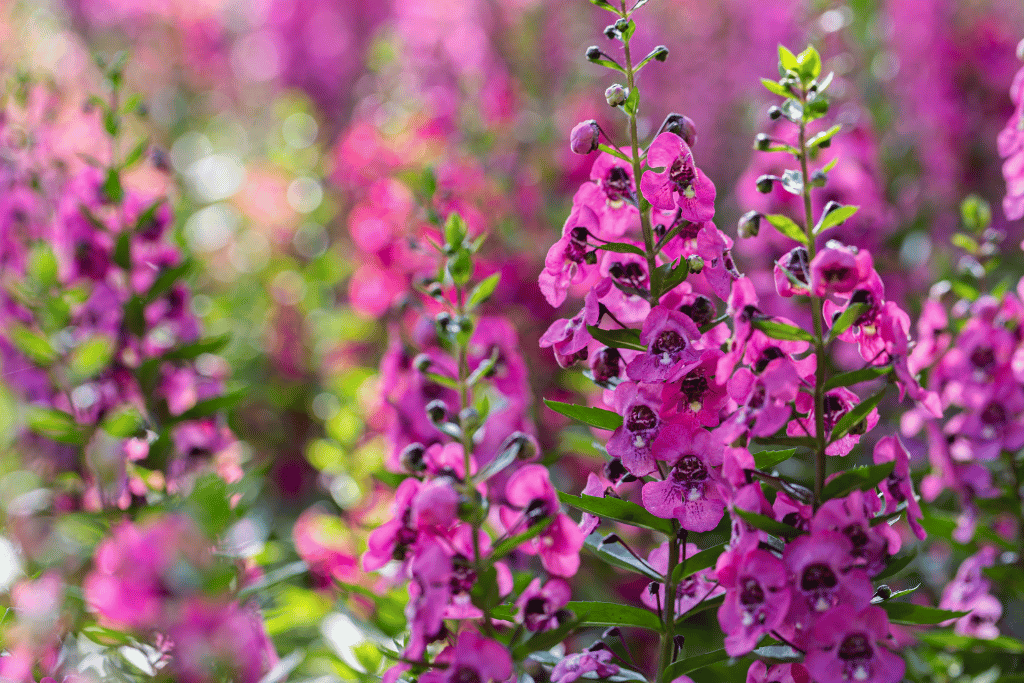
As a symbol of charm and grace, Angelonia’s tender appearance belies its resilience and adaptability. It is native to Central and South America, Angelonia blooms come in shades of purple, pink, white, and blue, creating a soothing and captivating display.
Angelonia, commonly known as Summer Snapdragon, is a charming annual or perennial plant with delicate spikes of snapdragon-like flowers.
With their extended bloom period and heat tolerance, Angelonia is an excellent choice for summer bedding and container gardening. Their compact size and low-maintenance nature make them ideal for adding pops of color to sunny borders and patio planters.
28. Antirrhinum – Snapdragons’ Whimsical Elegance

Antirrhinum are often associated with grace, strength, and protection, making them popular choices for bouquets and floral arrangements. They thrive in cooler temperatures and partial shade, gracing gardens with elegant charm and enduring beauty.
Antirrhinum, commonly known as Snapdragons, are whimsical and delightful flowers that belong to the Scrophulariaceae family. These cool-season annuals or perennials boast spike-like inflorescences with charming, snap-like flowers in a myriad of colors, including white, yellow, pink, red, and purple.
Snapdragons’ unique flowers can be “snapped” open and closed with gentle pressure, adding to their playful appeal.
29. Aethionema – Persian Candytuft’s Fragrant Magic

As a rock garden favorite, Aethionema adds a touch of magic to rocky slopes and alpine landscapes. Its evergreen foliage and beautiful blooms make it an appealing choice for adding charm and allure to gardens with well-draining soil and ample sunlight. Its petite, four-petaled flowers come in shades of pink, lilac, and white, forming delicate clusters that release a delightful fragrance.
Aethionema, commonly known as Persian Candytuft, is an enchanting and fragrant perennial plant native to rocky terrains in Iran and Turkey. Persian Candytuft’s aromatic blooms attract pollinators and contribute to the biodiversity of the ecosystem.
30. Alyssum – Delicate Carpet of Sweet Fragrance

Alyssum is also known for its versatility as a ground cover, edging plant, or filler in mixed containers. Its honey-like scent adds an enchanting touch to garden beds and outdoor spaces, inviting visitors and pollinators alike to savor its delightful aroma.
These dainty blooms form a velvety blanket that attracts pollinators, making it a valuable addition to pollinator-friendly gardens and containers.
Originating from the Mediterranean region, Alyssum showcases clusters of tiny, four-petaled flowers in shades of white, pink, lavender, or yellow. They, commonly known as Sweet Alyssum, is a delicate and charming flowering plant that graces gardens with its carpet-like growth and sweet fragrance.


